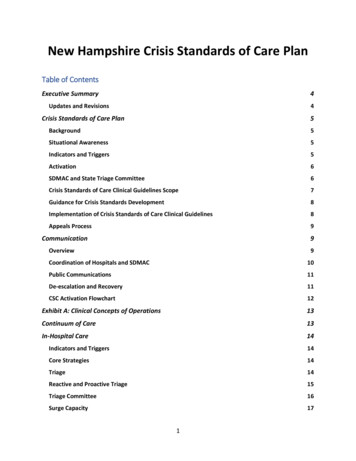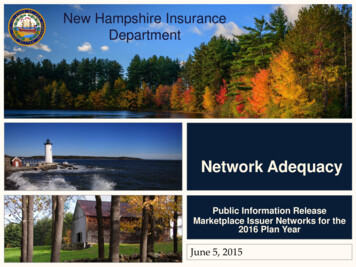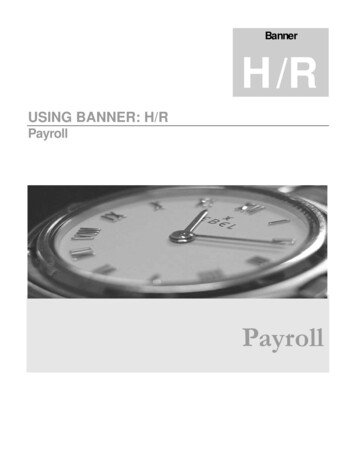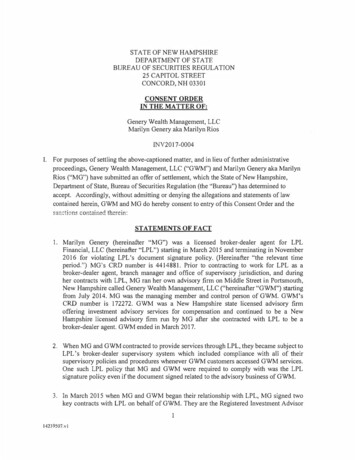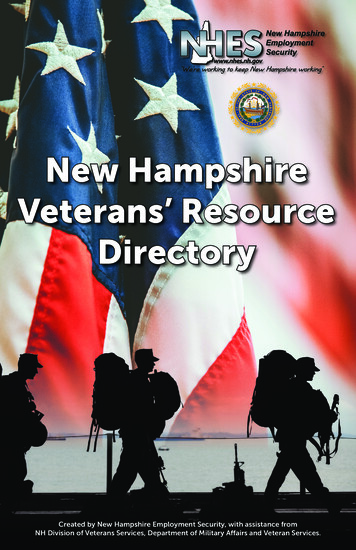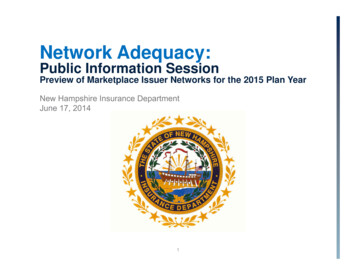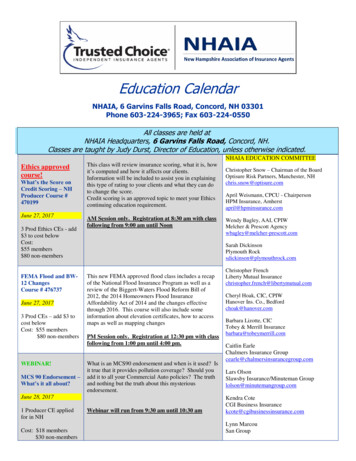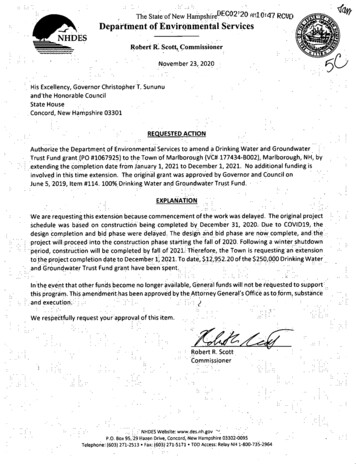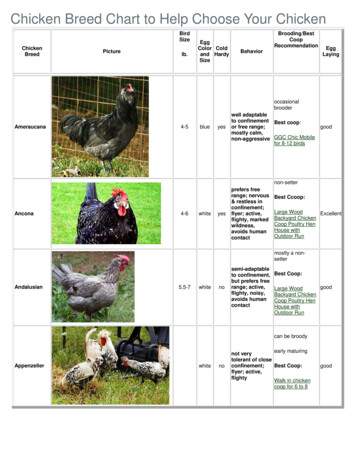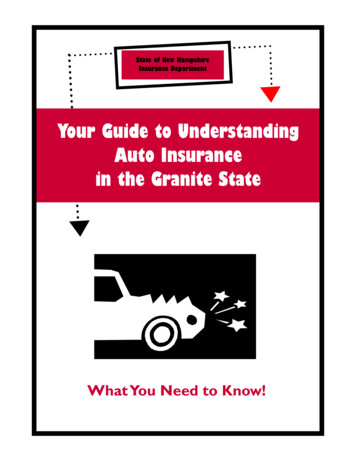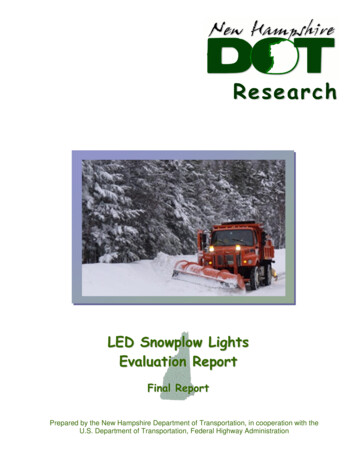
Transcription
ResearchLED Snowplow LightsEvaluation ReportFinal ReportPrepared by the New Hampshire Department of Transportation, in cooperation with theU.S. Department of Transportation, Federal Highway Administration
Technical Report Documentation Page1. Report No.2. Gov. AccessionNo.3. Recipient's Catalog No.FHWA-NH-RD-26962X4. Title and Subtitle5. Report DateLED Snowplow Lights – Evaluation ReportOctober 20206. Performing Organization Code7. Author(s)8. Performing Organization Report No.Daniel J. Fogg, Lane W. Evans, and Jay D. Ehmann9. Performing Organization Name and Address10. Work Unit No. (TRAIS)New Hampshire Department of TransportationBureau of Highway MaintenancePO Box 483Concord, New Hampshire 03302-048311. Contract or Grant No.26962X, A004(843)12. Sponsoring Agency Name and Address13. Type of Report and Period CoveredNew Hampshire Department of TransportationBureau of Materials & ResearchBox 483, 5 Hazen DriveConcord, New Hampshire 03302-0483FINAL REPORT (2018-20)14. Sponsoring Agency Code15. Supplementary NotesConducted in cooperation with the U.S. DEPARTMENT OF TRANSPORTATION, FEDERAL HIGHWAYADMINISTRATION16. AbstractThe NHDOT snowplow fleet currently uses halogen lights mounted on the push frame for night time snowplowingoperations. Due to the excessive vibration, frequent bulb replacement is necessary. Light-emitting diodes (LEDs)are less susceptible to vibrations and could reduce long term maintenance cost. Plow drivers have suggested thatLED lighting improves their visibility while operating as well as reducing the fatigue experienced during extendedhours of plowing. Mechanical Services does not have a firm policy on the use of LED headlamps and needs todetermine if the fleet would experience benefits by using LED bulbs. This project compared the use of halogenbulbs to heated LED bulbs. The results indicated that converting the NHDOT snowplow fleet from halogen bulbsto LED bulbs to reduces maintenance requirements, increases service life, and improves operator visibility forsafer snowplow operations.17. Key Words18. Distribution StatementLight emitting diodes, Snowplows, Winter maintenance, Maintenanceequipment19. Security Classif. (of this report)20. Security Classif. (of this page)UNCLASSIFIEDUNCLASSIFIED21. No. of Pages19No Restrictions. This document isavailable to the public through theNational Technical InformationService (NTIS), Springfield, Virginia,22161.22. Price
Report No. FHWA-NH-RD-26962XLED Snowplow LightsEvaluation ReportNovember 1, 2018 - December 31, 2020Prepared by:Daniel J. Fogg, Safety & Environmental Coordinator (SEC), District 1Lane W. Evans, SEC (Retired), District 3Jay D. Ehmann, SEC, District 3New Hampshire Department of TransportationBureau of Highway MaintenanceConcord, New HampshireOctober 2020
DISCLAIMERThis document is disseminated under the sponsorship of the New Hampshire Departmentof Transportation (NHDOT) and the U.S. Department of Transportation, Federal HighwayAdministration (FHWA) in the interest of information exchange. The NHDOT and FHWAassume no liability for the use of information contained in this report. The document does notconstitute a standard, specification, or regulation.The State of New Hampshire and FHWA do not endorse products, manufacturers,engineering firms, or software. Products, manufacturers, engineering firms, software or otherproprietary trade names appearing in this report are included only because they are consideredessential to the objectives of the document.ACKNOWLEDGEMENTSThe Bureau would like to thank the staff of NHDOT Maintenance Districts 1 and 3 andBureau of Mechanical Services for their participation in the administration of this project andtheir efforts in maintaining the field equipment and collecting data.Special thanks go to James K. Flanders, Highway Maintainer II, M-104 Patrol Shed,Groveton, New Hampshire, for initiating the conversation about LEDs within District 1Lancaster at the Internal Safety Committee level.Project Sponsor:Michael Servetas, P.E., Asst. Director of OperationsTechnical Advisory Group (TAG):Deirdre Nash, P.E., Asst. Research EngineerMichael Walsh, Asst. Administrator, Mechanical ServicesShawn Shattuck, Stockroom SupervisorDaniel J. Fogg, D1 Safety & Environmental CoordinatorLane W. Evans, D3 Safety & Environmental Coordinator (Retired)Jay D. Ehmann, D3 Safety & Environmental CoordinatorTAG Coordinator:Ann Scholz, P.E., Research Engineer
TABLE OF CONTENTSEXECUTIVE SUMMARY . 11. INTRODUCTION . 12. AUXILIARY HEADLIGHTS . 22.1 Halogen Headlight . 22.2 Light-Emitting Diode (LED) Headlight. 32.3 Installation of Lights . 43. TEST SITES . 44. DATA COLLECTION . 64.1 Operator Survey . 74.2 Supervisor Survey . 84.3 Public Survey . 95. SUMMARY AND CONCLUSION . 106. SURVEY DATA . 117. COST BENEFIT ANALYSIS . 128. ADDITIONAL INFORMATION . 129. RECOMMENDATION . 12REFERENCES . 13
EXECUTIVE SUMMARYThe NHDOT snowplow fleet currently uses halogen lights mounted on the push frame for nighttime and low-light snowplowing operations. Plow truck drivers have suggested that light-emittingdiode (LED) lighting may improve their visibility while operating as well as reducing thevisibility-related fatigue experienced during extended hours of plowing snow in darkness. Inaddition, excessive vibration of the equipment makes frequent bulb replacement necessary. LEDbulbs are less susceptible to vibrations and could reduce long-term maintenance costs. The Bureauof Mechanical Services does not have a firm policy on the use of LED headlights and needs todetermine if the fleet would experience benefits by using LED bulbs.The project compared the use of heated LED bulbs with halogen bulbs in headlights installed onNHDOT-owned plow trucks. The in-house research project targeted District 1 and District 3because of available interstate and rural routes. 72 heated LED headlights were purchased andinstalled on 17 plow trucks per district. Vehicle operators were chosen based on their particularroute to assess the variety of weather and traffic conditions. The operators completed surveysrelating their driving experience in a variety of weather conditions that include: clear, cloudy,snow, rain, freezing rain, sleet, wind, rain, fog, and blowing materials. Operators also monitoredmaintenance of equipment. Supervisors completed surveys relating their experience whenencountering the plow trucks on the road to assess visibility and if the LED headlights wereharmful to oncoming traffic. Feedback from the public was minimal.The surveys indicated that 98.5% of operator surveys reported better or much better visibility and97.8% better or much better peripheral visibility. 70.4% of operators reported less eye fatigue.91.4% of supervisor surveys reported better visibility and 72.4% better peripheral visibility. Inaddition, 60.3% of supervisors reported less eye fatigue with only three (3) occasions of blindingoncoming traffic. Regarding long-term maintenance cost, no LED headlights required replacementduring the duration of the project.1. INTRODUCTIONSnowplow vehicles and their operators often work in the harshest weather conditions at night withlimited visibility. Their visibility is affected by the intensity of the storm, type of precipitation,time of day, and the lighting systems installed on their vehicles. In addition, the severity of thevibration of the equipment during plowing operations necessitates frequent bulb changes, often asmany as four (4) bulbs per storm. This maintenance is costly and time consuming. The snowplowvehicle lighting system also affects other users of the highway when the plow truck meetsoncoming traffic. Providing better forward visibility for plow truck operators in adverse weatherconditions, reduced maintenance costs, and consideration for other users of the highway were theprimary focuses of this research project.Highway Maintenance employees in District 1 and District 3 work an average of 265,000 hoursper year with approximately 60% of those hours performing winter maintenance. Extendedovertime hours, often weeks at a time, affect the employee’s health and ability to do the job. At aDistrict 1 Internal Safety Committee Meeting, an employee proposed replacing the halogenheadlights that were standard equipment on fleet vehicles and on the plow frames of the plowtrucks. The proposed replacement was LED headlights.1
The recommendation was made to reduce driver eye fatigue by improving forward visibility andto reduce maintenance costs. A review of the Clear Roads study, Project 99006/CR14-0 61,indicated that many states have been experimenting with LED plow lights for years with overallpositive feedback. The light produced by LEDs is closer to that of daylight and LEDs have asignificantly longer service life. LEDs are becoming more common in newer vehicles.The objective of this NHDOT Highway Maintenance research project is to evaluate theperformance of the LED lights on plow frames of trucks during winter maintenance. Theevaluation will rely primarily on objective data from operators, supervisors, and the public. Basedon this data, a recommendation will be made to either continue using the halogen bulbs or convertthe NHDOT commercial vehicle fleet to LED headlights.2. AUXILIARY HEADLIGHTSPlowing snow involves a front mount push-frame installation on the front of the plow truck towhich a plow is attached. Some plows are fixed for discharge of snow to the right and some havea reversible plow for discharge to either right or left side. The plow is raised and lowered whenneeded or to clear obstructions in the road such as bridge expansion joints and railroad tracks.Having this additional frame and plow mounted to the front of the plow truck obstructs the truckmounted headlight making them unusable. This requires auxiliary headlights to be installed on thetop of the push frame. These auxiliary headlights become the primary means of forward lightingand directional signals. Visibility for snowplow operators is often reduced due to light reflectingback from blowing snow, fog, freezing rain, and blowing snow over-topping the plow. Theseconditions make the quality of the forward lighting very important. In addition, the vibrations ofthe equipment being in contact with the surface of the road shorten the service life of the headlights.2.1 Halogen HeadlightThe Wagner H6054, 5” x 7” Halogen Sealed Beam Headlight is the standard headlightinstalled and replaced on fleet vehicles within the NHDOT. The halogen light producesheat from the filament in the bulb which prevents snow and ice build-up in all but theharshest conditions. Similar to incandescent bulbs, the heat also makes the bulb moresusceptible to the vibration of the equipment and more prone to failure. Halogen bulbs haveproven reliable and provide a normal service life when used for routine maintenanceactivities. Unfortunately, the incandescent and halogen bulbs were not designed towithstand the extreme vibrations encountered when the plow is scraping the snow-coveredroadway. Operators often replace four (4) to six (6) halogen bulbs per storm event. Thecost per unit is 5.25 each.Overview:Wagner Sealed Beams are the original sealed beam that delivers brighter, whiter lightthan incandescent lighting. Shining up to 40% farther than incandescent lights, the nonreflective bottom shelf prevents glare in fog, rain and snow. Wagner-certified for longlasting dependability, they feature an extra strong filament design to withstand greatervibration and coated terminals to prevent corrosion.2
Features: Brighter, whiter light than incandescent lighting Prevents glare in fog, rain and snow Shines up to 40% farther than incandescent lighting Rugged vibration resistance High-grade stainless steel terminals Coated terminals to prevent corrosion DOT/Society of Automotive Engineers (SAE) compliant2.2 Light-Emitting Diode (LED) HeadlightThe JW Speaker 8910 Evolution 2, 5” x 7” LED Headlight with SmartHeat is the lightchosen for evaluation in the research project. This model was selected for a number ofreasons that include compatibility with existing light housings, service life and warranty,the SmartHeat feature, DOT compliance, and cost. A standard LED light generates verylittle heat thereby allowing snow and ice to quickly accumulate on the lens during snowevents. The 8910 model was chosen for evaluation because it offers a SmartHeat featurewhich automatically de-ices the headlight depending on ambient temperature. They have a2-year warranty with most still in service after five (5) years of use. The cost per unit is 206.04 each.Overview:The 8910 Evolution 2 provides a high performance 5” x 7″ LED headlight, available witha SmartHeat heated lens and Dual Burn technology. The 8910 Evolution 2 heated LEDheadlights provide a high performance safety solution with improved light output, and glarereduction.Features: Dual Burn high beam optics for extra punch of light Available with SmartHeat Technology that automatically de-ices headlightaccording to ambient temperature Meets proposed National Highway Transportation Safety Administration(NHTSA) guidelines for a 5-Star New Car Assessment Program-compliant lowbeam headlight Drop-in replacement heated LED headlights for typical buckets/panels used inheavy-duty trucks Tough, die-cast aluminum housing and polycarbonate lens, with added protectionfrom salt spray for efficient thermal management Superior condensation management Street legal supporting DOT, Transport Canada Economic Commission for Europe(ECE) and Military standards & requirements 5-Star NCAP-compliant Technology: The Model 8910 Evolution 2 will exceed theproposed Federal Motor Vehicle Safety Standards (FMVSS) 108 standard in atleast these three criteria, meeting 5-Star compliance:1. Light output, measured in lux2. Beam pattern, resulting in minimal glare3. Light placement, as dictated by mounting locations prescribed for vehicles3
Dual Burn Technology: Dual Burn technology goes beyond the average highbeam pattern with a three-part beam pattern designed to help people see better andstay safe.SmartHeat Heating System: The heated LED headlight, Model 8910 Evolution2, features a thermally conductive grid system that will de-ice the lens up to twiceas fast as other lights. This intelligent system reacts to temperature changes on areal-time basis with no action required by the driver.Street legal supporting DOT, ECE and Military standards: DOT versions are foruse in the U.S. DOT-compliant guarantees that the lights are legal on the road,meeting section 108 requirements of the Federal Motor Safety Standards. TheDOT-compliance is clearly etched on the lens of the light.Also available in a non-heated version (Model 8900 Evolution 2)2.3 Installation of LightsThe compatibility of the JW Speaker LED model to the existing vehicle light housingsmade the installation of the lights very simple. The halogen bulbs were removed and theLEDs were plugged into the 3-prong wiring harness. The lights were then adjusted properlyaccording to the State of New Hampshire inspections rules. Installation was performed bythe NHDOT Bureau of Mechanical Services heavy equipment mechanics at the servicegarages in Lancaster, Twin Mountain, Ossipee, and Concord.The headlights were installed to meet New Hampshire’s requirements of Chapter Saf-C3200 Official Motor Vehicle Inspection Requirements, Part Saf-C 3216, Headlight Aim(http://www.gencourt.state.nh.us/rules/state agencies/saf-c3200.html). The requirementsare outlined as follows:PART Saf-C 3216 HEADLAMP AIMSaf-C 3216.01 Headlight Aim.(a) A vehicle shall be rejected if:(1) A commercially manufactured aimer shows the headlight beam is notstraight ahead and 2 degrees down; or(2) A headlight board shows the headlight beam is not straight ahead andless than 2 inches lower than the horizontal center line of the board,measured 25 feet from the headlamps; or(3) Headlight aim is unachievable due to fogging or glazing of the lens orreflector.3. TEST SITESThe Technical Advisory Group (TAG) selected plow route test locations within Districts 1 and 3with consideration based on assessment of the LED headlight performance on remote, lower trafficvolume roadways like Route 3 in Pittsburg, NH, north to the border of Canada. Also chosen werehigh traffic volume sections of Interstate 93 in Franconia Notch and Littleton. District 3 locationswere likewise selected including remote, low volume Route 3 in Ellsworth and high volumeInterstate 93 north from Exit 27 to 32 and south from Exit 23 to Exit 20. The intention was to4
encounter a variety of winter conditions and traffic. The trucks and operators responsible for thewinter maintenance of these roadways were chosen to participate in the research.LED Lights - District OneDriver Name SectionTruckNo.TruckTypeRoute /RoadPlow RoutePittsburg, Upper shed to CanadianborderPittsburg, Lower shed toStewartstownLorne LeClaire101H43810 Wheeler Rte 3 North/SouthMike Hughes101H6433-5 TonRte 3 North/SouthSherman Coderre 103H5313-5 TonRte 16Thirteen Mile Woods, ErrolJohn Rooney104H5143-5 TonRte 3 North/SouthGroveton to North StratfordKeith Grenier105H5673-5 TonRte 110West Milan East to GrovetonDana Flynn107H6383-5 TonLost Nation Rd.North Road to Lost Nation RoadMichael Pickett 108H43010 Wheeler Rte 2Todd Webster125H1654 3-5 TonJason Marro112H44110 Wheeler Rte 302Marc Brodeur112H4873-5 TonRte 3Travis Spencer113H5403-5 TonRte 16Shawn Woods115H6133-5 TonRte 112Corey St. Cyr111H6623-5 TonRte.135Tyler Spaulding 124H41310 Wheeler I-93 North/SouthKyle Bryant124H42310 Wheeler I-93 North/SouthTodd Ferland125H6043-5 TonI-93William Nast125H1623 3-5 TonI-93Rt.1355Rte 2 Jefferson to Gorham Hill/Rte 115Harvey View Drive, Monroe toRte 18, LittletonCrawford Notch to Fourth IronBridgeTwin Mountain to Whitefield &Rte 115 to JeffersonGlen intersection North/South tomile marker 94.6Route 112, Lost River, Route 3 toRoute 116, EastonLittleton village to Bridge Hill Roadin DaltonFranconia Notch/Tandem with KyleBryantFranconia Notch/Tandem withTyler SpauldingLittleton, I-93 north to exit 40 (VTborder)Littleton, I-93 north to exit 40 (VTborder)
LED Lights - District ThreeDriver NameSectionTruckNo.TruckTypeRoute /RoadPlow RouteRte 3 from Rte 140 Rte 3, Rte 140 to Belknap to Belknap MallTilton/BelmontRte 140, 106, 107 3-5 TonRte 140Belmont/Gilmanton/LaconiaRte 107, Rte 140, Rte 129 3-5 TonRte 107GilmantonRte 106, Rte 140 3-5 TonRte 106Concord/Loudon/CanterburyI-93 – New Hampton/Meredith/10 Wheeler I-93Sanbornton/TiltonI-93 - New Hampton/Ashland/10 Wheeler I-93Holderness/Plymouth/CamptonI-93 - Campton/Thornton/10 Wheeler I-93Woodstock/LincolnEllsworth Hill Road,3-5 TonRte 49Campton/EllsworthKyle Bilodeau313H641Bill Laflam314H457Dana Decormia314H635Warren Merrill316H585James Eckert324H440Arthur Desroisiers 324H463Paul Lebreck325H479Dillon Trott325H548Chris Plancon309H16453-5 TonWilliam Chick301H40410 Wheeler Rte 16Rte 16 - Albany/ConwayBlair Eastmans301-6063-5 TonRte 113Rte 302 - Conway/ChathamKeith Ross302H6243-5 TonRte 16George Boewe303H4983-5 TonRte 153Richard Atwood305H16493-5 TonRte 113Richard Maloney 311H5833-5 TonRte 109Gene DoeH15003-5 TonRte 16H6793-5 TonRte 16Rte 16 - WakefieldH6733-5 TonRte 11Rte 11 - Alton/New DurhamCurrie DeBowDonald White3123123153-5 TonRte 3 & Rte 25Rte 3 - MeredithRte 16, Rte 25 Ossipee/TamworthRte 153, Rte 25 Freedom/Madison/EatonRte 113, Rte 3 Tamworth/Sandwich/HoldernessRte 109, Rte 109A Jct. Tuftonboro/WolfeboroRte 16, Rte 28 Ossipee/Wakefield4. DATA COLLECTIONThe Technical Advisory Group (TAG) prepared surveys relevant to the operators, the supervisors,and the public. The surveys were distributed as appropriate and requested to be completed duringweather events. The surveys were returned to the district offices on a biweekly schedule. The datawas then compiled on a spreadsheet for review. 135 operator surveys, 58 supervisor surveys, and4 public surveys were completed during the research period.6
4.1 Operator Survey7
4.2 Supervisor Survey8
4.3 Public Survey9
5. SUMMARY AND CONCLUSIONThe research project began at an Internal Safety Committee meeting in District 1 in February 2018.Highway Maintainer II, James K. Flanders, from the M-104 Patrol Crew in Groveton, NewHampshire, requested permission to replace the halogen auxiliary headlights with LED headlightsto improve the forward illumination of his 3/5-ton plow truck and reduce the fatigue experiencedwhen plowing snow particularly at night. Flanders request was denied because LEDs are notstandard issue for that truck model and NHDOT does not have a firm policy on their use.The topic was then discussed in May 2018 at the NHDOT Unit Safety Committee and a task forcewas created to examine the merits of LED headlights versus halogen. The task force recommendedfurther research on the subject and a problem statement was presented to the NHDOT ResearchAdvisory Council with request for funding. The research project was approved and funding of 15,000.00 was authorized. 72 LED headlights were purchased to retrofit 17 trucks in bothDistricts 1 and 3. Because of the late start in the 2018-2019 winter season, the research portion ofthe project was postponed until the winter of 2019-2020. Surveys were completed and researchwas terminated in May 2020.Data from the surveys has been consolidated in the spreadsheet included in Section 6 Survey Data.The data is objective and based on the opinions of operators, supervisors, and limited publicfeedback. However, it is very clear from the collective data that the LED lights were anoverwhelming improvement over the standard issue halogen lights installed on the fleet vehicles.The research supports the original proposal that LED light conversion from halogen lights willreduce maintenance requirements, increase service life, improve operator visibility for safersnowplow operations, lessen eye fatigue, and has the potential to improve employee morale andpublic safety.10
6. SURVEY DATA11
7. COST BENEFIT ANALYSISAlthough the Department has not tracked the supply and maintenance costs of using halogenheadlights, a comparison between this practice and the use of LED headlights was analyzed. Onaverage, the maintenance sheds involved with this study are out plowing for 40 to 50 storm eventsper season. Most of these storms require the use of the plow headlights due to darkness or overcastskies causing low sunlight, therefore the comparison was based on 40 events. During each storm,a halogen bulb may need to be replaced one to two times because of the heat generated by the bulbor excess vibration from roadway condition such as frost heaves or poor pavement surface. Thetime allotted for the plow truck operator to return to the shed and replace the blown bulb is onehour. The average pay for highway maintainers during storm events is 24.52/hour. Based on thisdata, the current practice costs the Department 1,295.80 per truck per season. In comparison,none of the LED headlamps required replacement during the test period resulting in a total cost of 206.04 per truck per season. One additional cost benefit not reflected in the table is that the LEDheadlamps have a two-year warranty and may last up to five (5) years.BulbCost#Replacedper stormHalogen 5.251.5LED 206.04 0AverageOperator# oftime tostormsreplace (hr.)40140NAPay rate Material(per hr.)cost 24.52 24.52 315.00 206.04Laborcost 980.80 0.00Totalcost/truck/season 1,295.80 206.048. ADDITIONAL INFORMATIONOne of the main concerns of snowplow operators is the light bounce-back from the auxiliaryheadlights during some adverse weather conditions particularly at night. During hours of darkness,operators often experience reflected light from falling snow and ice that contributes to eyediscomfort and fatigue. An observation made by several operators was the need to consider alteringthe mounting locations of the auxiliary headlights such that it is away from the driver’s line ofsight. It should be noted that the LED mounting location for this research project was in theprevious location of the halogen light housings.9. RECOMMENDATIONWinter maintenance operators report feeling fatigued at some point while operating a snowplowduring a storm. In addition to limited visibility, particularly at night and in the worst weatherconditions, these operators are not restricted by hours-of-service rules and frequently workextended hours. These long stressful hours potentially contribute to increased accident rates, healthissues, lower morale, and reduced productivity. Clear Roads Research Project 99006/CR14-061and Project 1001325/CR15-022 suggest that LED lighting has been found to greatly improvenighttime visibility and reduce operator fatigue. Project 10011325/CR15-022 further recommendsthat winter maintenance agencies should replace headlights, plow lights, and other auxiliary lightbulbs with LEDs.Based on the feedback in the operator surveys and observations by the supervisors in this researchproject, conversion from halogen headlights to LEDs is recommended. In addition, new equipmentspecifications should include LED headlights when new vehicles are purchased.12
REFERENCES1. Muthumani, A., Fay, A., Bergner, D. (2015) Use of Equipment Lighting During SnowplowOperations. (Report No.CR14-06). St. Paul, MN: Minnesota Department ofTransportation, Clear Roads Pooled Fund.2. Camden, MC., Hickman, J.S., Soccolich, S.A., Hanowski, R.J. (2017) Identification andRecommendations for Correction of Equipment Factors Causing Fatigue in SnowplowOperations. (Report No. CR15-02). Blacksburg, VA: Virginia Tech TransportationInstitute, Clear Roads Pooled Fund.13
The Wagner H6054, 5” x 7” Halogen Sealed Beam Headlight is the standard headlight installed and replaced on fleet vehicles within the NHDOT. The halogen light produces heat from the filament in the bulb which prevents snow and ice build-up in all but the harshest conditions. Similar to incandescent
